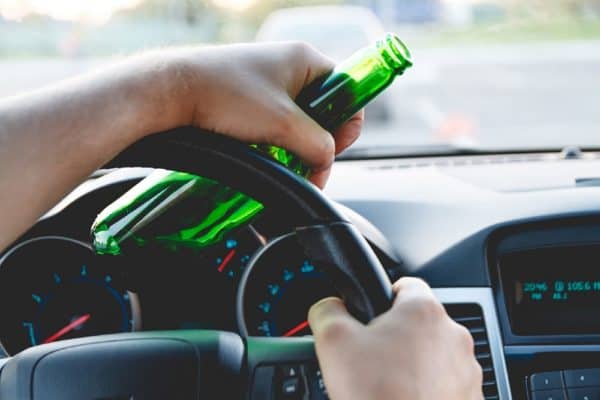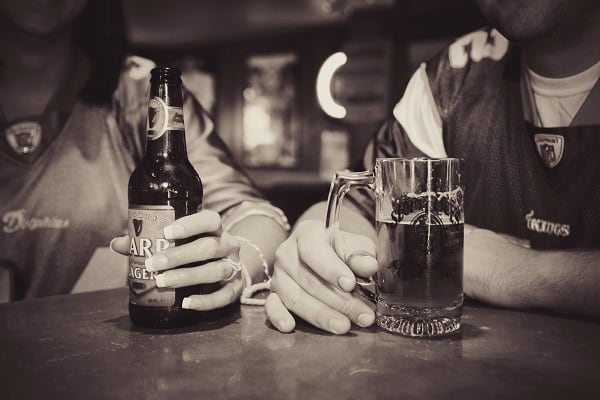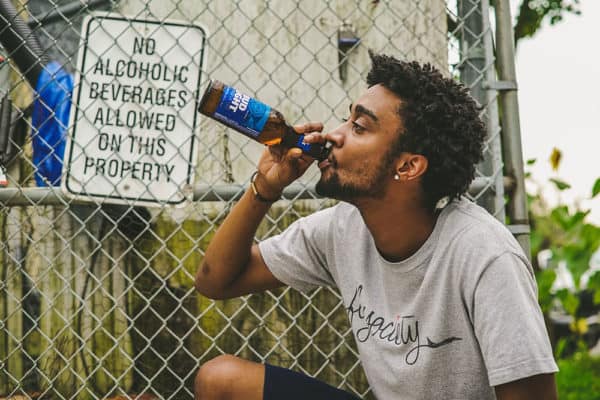This is a true story. It happened, only last month, and here in Washington state. Only the names of those involved have been changed. Everything else is a sad statement of fact. Three young female friends – let us call them Sandy, Bernice, and Carrie – went to a party one Thursday night over in Tacoma, and Sandy, aged 18, drove all three of them. At that party, Sandy drank a few glasses of cognac. When leaving, Sandy apparently insisted on driving back – Bernice, who even offered to drive but was refused, rode shotgun, while Carrie sat in the back. On the nearby Interstate, Sandy lost control of the car, and they hit the guardrail, dangerously coming to rest across the traffic flow. Unfortunately, the lights on the car were severely damaged, and no longer worked. An oncoming pick-up truck, unaware of the imminent danger, then collided with Sandy’s stationary car. Carrie sat in the back, and only 20 years old, was killed as a result of that collision. Sandy and Bernice were injured, though, fortunately for them, not seriously. Unlike Carrie, their injuries were nowhere near fatal.
“Get your loved one the help they need. Our substance use disorder program accepts many health insurance plans, this is our residential program.”
Washington State Patrol was quickly on the scene. Availing themselves of the sad situation, they duly conducted sobriety tests, and Sandy was breathalyzed. The breath sample tested positive for alcohol. Sandy, just 18 remember, has now been charged with vehicular homicide, as a direct result of Carrie’s death, as well as vehicular assault. Under Washington state law, she faces the very real prospect, if convicted, of life imprisonment and/or a maximum $50,000 fine. Her life may well turn out to be very different from the one she had hoped for. Carrie’s life is over, and the lives of her family and friends have been changed forever. Convicted or not, the lives of Sandy, and her family and friends, have been changed in a slightly different way. To everybody else, they are just more statistics to add to Washington state’s seemingly endless battle against its major issue with alcohol abuse and alcoholism, a battle proving to be much harder than the average U.S. state.

Alcohol Abuse Statistics for the U.S.
According to an in-depth study of alcohol use disorders (AUD) in the first decade of this millennia, alcoholism rates rose by an astonishing 49% during that time. This means that 12.7% of the U.S. population now meets the official diagnostic criteria for alcohol use disorder. That is a deeply disturbing ratio of 1 alcoholic in every 8 adults. Furthermore, the U.S. Centers for Disease Control and Prevention (CDC) reports that around 88,000 people a year will die of alcohol-related causes. That is more than twice the number of people who die from opiate overdoses, which, along with opioids, is now considered a national crisis. Again looking nationally, every 50 minutes a person will die in a DUI-related motor vehicle accident in the U.S. That’s 29 people every single day. The annual cost to the U.S.of alcohol-related motor vehicle accidents exceeds $44 billion. The full economic burden placed on the entire U.S. from excessive alcohol consumption stands at a colossal $249 billion (nearly a quarter of a trillion dollars).
“We treat both addiction and co-occurring disorders and accept many health insurance plans. Take a look at our inpatient program.”
How Does Washington State Compare?
In Washington state, the ratio of AUDs and other excessive alcohol consumption (including binge drinking) per capita is higher than the national average, and that includes incidences of driving under the influence (DUI), just like 18-year-old Sandy’s. In Ferry County, WA, alone,the rate of car accident deaths involving alcohol at stands at 63%, which is far higher than the national average. The economic burden placed on the state of Washington by excessive alcohol consumption, as you can imagine, is above average too. In fact, it amounts to a huge $5.8 billion every year from losses in workplace productivity, health care expenses, criminal justice expenses, motor vehicle crash costs, and property damage.
Binge Drinking: U.S. vs Washington State
The National Institute on Alcohol Abuse and Alcoholism (NIAAA) defines binge drinking, which many experts consider as a gateway to wider alcohol abuse and alcoholism, as “a pattern of drinking that brings a person’s blood alcohol concentration (BAC) to 0.08 grams percent or above. This typically happens when men consume 5 or more drinks or women consume 4 or more drinks in about 2 hours.” In simple terms, drinking large amounts of alcohol very quickly.
Binge Drinking: The Socially Acceptable Form of Alcohol Abuse
Without a doubt, binge drinking is the abuse of alcohol. However, in a social setting, surrounded by others engaging in binge drinking, it is widely seen as normal, acceptable, and often expected, especially among young adults. It is estimated that, in 2018, around 17.4% of U.S. adults engaged in binge drinking at some point. Washington state comes below the national average, at around 15.6%. However, as with the majority of other states, here in Washington state, certain counties have significantly higher rates of binge drinking than the state average. San Juan, Ferry County, Grays Harbor, and King counties reported rates well above the average, with figures of 22%, 21%, 21% and 17% of adults binge drinking during the last month, respectively. 
Underage Drinking in WA State
In Washington state, and mirrored across every other state in the U.S., a new generation of potential alcoholics are becoming grown adults – people just like Sandy from our story earlier. The problem of children and young adults (those under the age of 21) cost the state of Washington $1.4 billion in 2007, according to the CDC, and included resulting medical care, and revenue from work loss. The 2016 Healthy Youth Survey taken by 6th, 8th, 10th, and 12th graders in Washington state produced worrying results:
- Most WA state students reported drinking 1-2 days during the month (with 12th graders reporting an exceedingly high rate of 32%)
- Among those students who drink, the majority use hard liquor, increasing their risk of alcohol poisoning
- Nearly 20% of 10th graders and 17% of 12th graders reported traveling in a car with a driver who had recently consumed alcohol
- Around 9% of 12th graders admitted to driving after using alcohol
Who is a Casual Drinker?
The term “casual drinker” covers a wide spectrum of those who drink alcohol responsibly, and at relatively safe rates of consumption. The Dietary Guidelines for Americans defines moderate drinking as:
- Up to 1 drink per day for women
- Up to 2 drinks per day for men
In fact, the Dietary Guidelines recommend that if you don’t drink alcohol at present, it is far better to remain that way. Additionally, it is important to remember that there are some people who should not drink any alcohol – these groups include:
- Those younger than age 21
- Those who are pregnant or may be pregnant
- Those who drive, and those who “participate in other activities requiring skill, coordination, and alertness”
- Those taking prescriptions or over-the-counter medications that can interact with alcohol
- Those with certain medical conditions
- Those recovering from alcoholism or who are unable to control their drinking
From this advice, which is used by the CDC, casual drinking is determined as a pattern of low-risk drinking that involves consuming alcohol in low doses, and only on occasion. Often referred to as “social drinkers,” those who drink casually, typically drink alcohol no more than once or twice a week.
“We accept many health insurance plans. Get your life back in order, take a look at our residential program.”
Who is an Alcoholic?
Furthermore, and as revealed in extensive published medical research in 2018, no level of alcohol consumption should be regarded as safe, whether you qualify as a casual drinker or not. Referencing global data, this study found that alcohol is the 7th. leading cause of death worldwide yet is the leading cause among 15-49 year olds. Here in the U.S., a CDC-referenced study published in 2014 found that 1 in 3 adults is considered to drink excessively, with many regularly engaging in binge drinking. Whether this means they are potentially suffering from an AUD is quite a different matter, but the correlation between binge drinking and alcoholism is clear and established. The results of the CDC study found that excessive drinking, binge drinking, and alcohol dependence (AUDs) were most common among men and those aged 18 to 24. The prevalence of an AUD was 10.2% among those who drank excessively, 10.5% for those who qualified as binge drinkers, and only 1.3% among non-binge drinkers. These figures show a direct link between binge drinking and AUD. The simple criteria for assessing whether an individual has an Alcohol Use Disorder (more commonly known as alcoholism), according to the “Diagnostic and Statistical Manual of Mental Disorders, 5th Edition (DSM-5),” is that “alcohol is often taken in larger amounts or over a longer period than was intended.” 
How Does AUD Develop?
If you regularly drink excessively, you are putting yourself at serious risk of developing an AUD. How quickly the disorder develops is dependent upon a number of factors, such as genetics, sex, and age. High rates of alcohol consumption will, in time, change the chemistry of your brain, thus leading to the build-up of a level of tolerance – a level that will only build further unless you make serious changes to your current drinking habits. Over time, if you wish to achieve the same effect that alcohol previously gave you, you will need to increase your consumption. If that consumption is allowed to continue unabated over a long period of time, you will develop a dependence on alcohol, and an AUD is virtually guaranteed. Alcoholism is an unrelenting downward spiral for the addict because those with an AUD will quickly experience withdrawal symptoms should they abruptly stop their drinking. Those withdrawal symptoms can include:
- Difficulty sleeping
- Irritability and restlessness
- Shaking
- Headache
- Nausea
- Sweating
- Anxiety and/or depression
Severe cases of withdrawal from alcohol may result in a condition known as delirium tremens (or DTs), which can result in fever, seizures, paranoia, and hallucinations, and, in extreme cases, coma and even death.
Alcohol Poisoning: Signs & Symptoms
Furthermore, alcoholics are more prone to life-threatening overdoses, known as alcohol poisoning, although not exclusively – the casual drinker who drinks alcohol to severe excess can also experience an overdose. Alcohol poisoning causes severe problems with breathing, heart rate, body temperature, and the gag reflex. Signs and symptoms can include:
- Vomiting
- Choking
- Confusion
- Slow and/or irregular breathing
- Pale or blue-tinged skin
- Seizures
- Low body temperature
- The toxic buildup of substances called ketones in the blood known as alcoholic ketoacidosis
- Unconsciousness
Alcoholism in WA State vs U.S.: Official Statistics
Using official information taken from the 2011 and 2012 National Survey of Drug Use & Health data reports, Washington state has a significantly higher rate of alcohol use disorder per capita than the U.S. average:
| Washington state | United States | ||
| Age range: | % per capita: | Age range: | % per capita: |
| 12-17 | 1.57% | 12-17 | 1.34% |
| 18-25 | 7.19% | 18-25 | 6.01% |
| 26+ | 3.26% | 26+ | 2.90% |
Who is the “High Functioning” Alcoholic?
High-functioning alcoholics are people who appear to many to function relatively normally despite being addicted to alcohol. Many of these alcoholics, who have yet to exhibit the same social and professional dysfunctions as their more stereotypical counterparts, tend to keep their alcoholism a secret. However, their deteriorating emotional state can be just the same as the more “textbook” alcoholic. Because of the secretive and functional nature of this type of alcoholism, accurate statistics reflecting the issue are difficult to ascertain. 
Signs & Symptoms of a High-Functioning Alcoholic
It is worth remembering that people suffering from an AUD don’t simply fall into either highly-functional or dysfunctional. NIAAA researchers have developed their 5 categories of AUD, and all demonstrate differing signs and symptoms:
- Young adult
- Young antisocial
- Intermediate familial
- Functional
- Chronic severe
The signs and symptoms most associated with “functional” alcoholism include:
- Using alcohol to relax, and give confidence
- Morning drinking
- Drinking alone and excessively
- Prone to blackouts
- DUI arrest record
Functional alcoholics are also more likely to participate in high-risk behaviors; however, the have become adept at not being caught. These high-risk behaviors include:
- Binge drinking
- Drinking while taking care of their children
- Driving under the influence
- Practicing unsafe sex after drinking
Treatment for Alcohol Use Disorder
Because of the possibly severe nature of withdrawal symptoms, quitting excessive alcohol use by simply stopping immediately, ie. going “cold turkey,” is highly inadvisable, and potentially, in extreme cases, prove fatal. Additionally, the chances of a relapse back into alcohol abuse is high. For this reason, it is far better and safer to find a professional medically-assisted detox program, as either an inpatient or an outpatient, to withdraw from alcohol. The main advantages of this are:
- Professional medical supervision during the detox
- Specialized medication to ease the worst of the withdrawal symptoms
- A limited number of facilities, including Northpoint Washington, our highly specialized inpatient drug and alcohol addiction treatment center in Edmonds, WA., also offer therapeutic activities to ease withdrawal
- Simultaneous treatment for co-occurring disorders, eg. when a patient presents with both alcoholism and a mental disorder
- Detox is the first step in a treatment process that is designed to ensure only a very minimal risk of relapse
At Northpoint Washington, we offer a unique alcohol detox and rehab program that features both medical intervention and holistic therapies, as well as the best research-supported traditional alcohol rehabilitation treatments. Our 28-day inpatient alcohol treatment program will treat both the body, with medical detox and the mind, with our rehabilitation services, designed to help you understand the psychological aspects of addiction. Our ongoing treatment includes:
- Relapse prevention
- Integrated treatment and medical intervention
- Psychiatric care and medications for co-occurring disorders
- Family therapy
- Behavioral therapy
- Educational workshops and skill-building activities
- Group therapy and support
We recommend that all patients then transition into the more flexible outpatient program, designed to allow your successful return into daily life, and which continues to incorporate the main elements of our treatment program. Please remember that alcohol use disorder is a chronic, relapsing brain disorder, and requires professional medically-assisted treatment, certainly at the beginning of your recovery. If the disorder is allowed to continue its destructive path untreated, it will undoubtedly make your life utterly miserable. Who knows? Don’t let your future become a mere statistic, and a promise that has been lost, just like Sandy’s.
